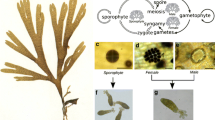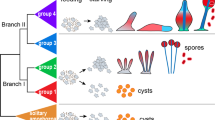Abstract
Chimerism theoretically increases the genetic heterogeneity of coalescing organisms, which in turn may increase phenotypic variability in chimeras, allowing them greater tolerance to environmental changes when compared with non-coalescing individuals. In order to test this hypothesis, we compared abiotic stress tolerance between coalescing and non-coalescing organisms. The specific daily growth was compared using discs formed with 1, 5, and 20 Mazzaella laminarioides carpospores. These were cultivated under three different temperature (6, 12, and 25 °C) and salinity (10, 35, and 50 g L−1) conditions. Growth of the disc area was measured after 30 days of cultivation under controlled conditions. Sporeling survival similarly was calculated under each of these temperatures and salinities in order to record whether stress-resistant phenotypes were present. The results showed that, under stressful conditions, non-coalescing specimens experienced a significant reduction in the specific growth rate compared with those under non-stressful conditions. The reduction in growth falls off, however, as the number of coalescing spores increases. The cultivation of spore populations also indicates the presence of sporelings with the capacity to survive alone in stressful situations. The results suggest that the coalescing discs exhibit higher tolerance to environmental stressors than non-coalescing discs, allowing them to survive and grow under these conditions. This can be explained by an increase in phenotypic plasticity, resulting from greater genetic heterogeneity due to somatic fusion of a larger number of spores.



Similar content being viewed by others
References
Clark JS, Poore AGB, Ralph PJ, Doblin MA (2013) Potential for adaptation in response to thermal stress in an intertidal macroalga. J Phycol 49:630–39
Correa JA, McLachlan J (1991) Endophytic algae of Chondrus crispus (Rhodophyta). J Phycol 27:448–59
De Miranda G, Yokoya N, Fujii M (2012) Effects of temperature, salinity and irradiance on carposporeling development of Hidropuntia caudata (Gracilariales, Rhodophyta). Braz J Pharmacognos 22:818–24
DeWitt T, Sih A, Sloan Wilson D (1998) Costs and limits of phenotypic plasticity. TREE 13:77–81
Eggert A (2012) Seaweed responses to temperature. In: Wiencke C, Bischof K (eds) Seaweed biology, novel insights into ecophyisiology, ecology and utilization. Ecological Studies 219. Springer, Berlín, pp 47–66
González A, Santelices B (2008) Coalescence and chimerism in Codium (Chlorophyta) from central Chile. Phycologia 47:468–78
González AV, Borras-Chavez R, Beltrán J, Flores V, Vásquez JA, Santelices B (2014) Morphological, ultrastuctural, and genetic characterization of coalescence in the intertidal and shallow subtidal kelps Lessonia spicata and L. berteroana (Laminariales, Heterokontophyta). J Appl Phycol 26:1107–13
Hughes RN (2002) Genetic mosaics and chimeras. In: Adiyodi KG, Hughes RN (eds) Reproductive biology of invertebrates, volume XI, progress in asexual reproduction. Oxford and I.B.H. Publishing, New Delhi, pp 159–73
Karsten U (2012) Seaweed acclimation to salinity and desiccation stress. In: Wiencke C, Bischof K (eds) Seaweed biology, novel insights into ecophyisiology, ecology and utilization. Ecological Studies 219. Springer, Berlín, pp 87–108
Kirst G (1989) Salinity tolerance of eukaryotic marine algae. Annu Rev Plant Physiol 40:21–53
Littler M, Littler D (eds) (1985) Handbook of phycological methods: volume 4: ecological field methods: macroalgae. 1st Edition. Cambridge University Press, Cambridge, pp 462–77
Maldonado M (1998) Do chimeric sponges have improved chances of survival? Mar Ecol Prog Ser 164:301–06
Muñoz J, Finke R, Camus P, Bozinovic F (2005) Thermoregulatory behavior, heat gain and thermal tolerance in the periwinkle Echinolittorina peruviana in central Chile. Comp Biochem and Physiol A 142:92–8
Muñoz J, Camus P, Labra F, Finke R, Bozinovic F (2008) Thermal constraints on daily patterns of aggregation and density along an intertidal gradient in the periwinkle Echinolittorina peruviana. J Therm Biol 3:149–56
Pineda-Krch M, Lehtilä K (2004) Costs and benefits of genetic heterogeneity within organisms. J Evol Biol 17:1167–77
Rinkevich B (2005) Natural chimerism in colonial urochordates. J Exp Mar Biol Ecol 322:93–109
Rinkevich B, Weissman IL (1987) Chimeras in colonial invertebrates: a synergistic symbiosis or somatic- and germ-cell parasitism? Symbiosis 4:117–1134
Santelices B (2004) A comparison of ecological responses among aclonal (unitary), clonal and coalescing macroalgae. J Exp Mar Biol Ecol 300:31–64
Santelices B, Alvarado J (2008) Demographic consequences of coalescence in sporeling populations of Mazzaella laminarioides (Gigartinales, Rhodophyta). J Phycol 44:624–36
Santelices B, Correa J, Meneses I (1996) Sporeling coalescence and intraclonal variation in Gracilaria chilensis (Gracilariales, Rhodophyta). J Phycol 32:313–22
Santelices B, Correa J, Aedo D, Hormazábal M, Flores V, Sánchez P (1999) Convergent biological processes among coalescing Rhodophyta. J Phycol 35:1127–1149
Santelices B, Aedo D, Hormazábal M, Flores V (2003a) Field testing of inter- and intraespecific coalescence among mid-intertidal red algae. Mar Ecol Prog Ser 250:91–103
Santelices B, Correa JA, Hormazábal M, Flores V (2003b) Contact responses between spores and sporelings of different species, karyological phases and cystocarps of coalescing Rhodophyta. Mar Biol 143:381–92
Santelices B, Alvarado J, Chianale C, Flores V (2010) The effects of coalescence on survival and development of Mazzaella laminarioides (Rhodophyta, Gigartinales). J Appl Phycol 23:395–400
Sokal RR, Rohlf FJ (1995) Biometry: the principles and practice of statistics in biological research, 3rd edn. W.H. Freeman, New York, p 887
Sultan S (2000) Phenotypic plasticity for plant development, function and life history. Trends Plant Sci 5:537–42
Ulloa O, Escribano R, Hormazabal S, Quiñones R, González R, Ramos M (2001) Evolution and biological effects of the 1997–98 El Niño in the upwelling ecosystem off northern Chile. Geophys Res Lett 28:1591–4
Acknowledgments
We are grateful for the funding awarded by FONDECYT (Fondo Nacional de Desarrollo Científico y Tecnológico) 1120129 and FONDECYT 11110120.
Author information
Authors and Affiliations
Corresponding author
Rights and permissions
About this article
Cite this article
Medina, F.J., Flores, V., González, A.V. et al. Coalescence increases abiotic stress tolerance in sporelings of Mazzaella laminarioides (Gigartinales, Rhodophyta). J Appl Phycol 27, 1593–1598 (2015). https://doi.org/10.1007/s10811-014-0478-0
Received:
Revised:
Accepted:
Published:
Issue Date:
DOI: https://doi.org/10.1007/s10811-014-0478-0




